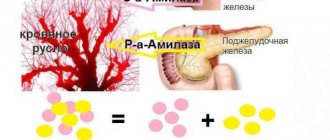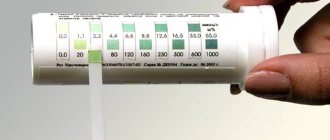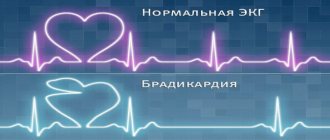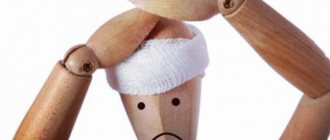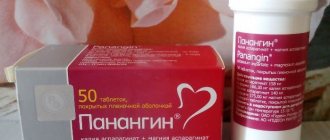5606
Reduced levels of total bilirubin can lead to serious complications. Doctors note that this condition indicates pathological conditions in the body.
Bilirubin is a half-life product of hemoglobin. The substance is responsible for the correct chemical composition of bile produced by the bone marrow and spleen.
Bilirubin is a red-brown bile substance that combines with glucuronic acid. It passes through all the bile ducts, after which it enters the duodenum. The average lifespan of a bilirubin cell is 100 days.
When is a bilirubin test prescribed?
A bilirubin level test is prescribed for:
- various jaundices;
- carrying out differential diagnosis of types of jaundice;
- suspected hyperbilirubinemia;
- cholestasis (stagnation of bile);
- cholelithiasis;
- liver diseases;
- diseases of the biliary tract;
- hepatosplenomegaly (enlarged liver and spleen);
- infectious diseases accompanied by liver damage;
- taking medications that have hepatotoxic effects;
- hemolytic anemia;
- diseases of the cardiovascular system.
How to take tests correctly
Very often, low direct bilirubin levels may be the result of improper blood sampling, or inadequate preparation of the patient for this procedure.
It is important to know that before taking a biochemical analysis you must:
- during the day before blood sampling, do not eat fatty foods, which increase the load on the liver;
- 10–14 days before the test, do not take medications or, if possible, limit their intake; tablets increase the concentration of the substance in the blood;
- limit sports and heavy physical activity;
- try to avoid stress: a strong emotional outburst can also affect the composition of the blood;
- limit or eliminate the consumption of alcoholic beverages that lead to a decrease in the studied indicator;
- compliance with the drinking regime is also important: you should reduce caffeine consumption (or completely abandon it), but drinking plenty of plain water, on the contrary, helps to obtain reliable indicators;
- Smoking (nicotine) affects the unreliability of the indicator.
If, after a repeated blood test, the indicators have not changed significantly, then you should undergo a full diagnostic examination of the whole body to make a correct diagnosis.
Preparing for analysis
To get the correct test results, the patient is sent for a biochemical blood test. To obtain correct results, you should prepare for the study. The following rules must be observed:
- 3 days before the test, avoid eating fatty, fried foods, which cause the liver to work intensively;
- For a week, you should eliminate alcoholic beverages from your diet and stop smoking;
- Stop taking medications several weeks before the test;
- It is worth completely minimizing physical activity and psychological stress, which also affects chemical processes in the body;
- Try to drink as much clean water as possible - this will help start metabolic processes.
If you follow all the preparatory rules for the tests, you will be able to obtain the correct results of clinical studies.
If you get a bad result, you will definitely be sent for a repeat test - it will help eliminate the possibility of a medical error.
Causes of low bilirubin
Despite the fact that the most common change in bilirubin level is upward, a decrease in it is also quite important.
Low bilirubin is a consequence of the following diseases:
- renal failure;
- acute leukemia;
- tuberculosis intoxication;
- nutritional exhaustion;
- aplastic anemia.
Reduced total bilirubin in an adult: what does this mean? The reason for the decrease in total bilirubin during such diseases is the low content of red blood cells in the blood, as a result, the concentration of pigment decreases due to the small number of destroyed red blood cells.
A deviation from the norm is the presence of bilirubin in the blood below 3 mmol/l.
When analyzing blood for bilirubin levels, it is important to take into account the time of blood sampling from the patient. At night there is an increase in bile pigment; By the end of the day, bilirubin often decreases slightly. Failure to follow the rules when taking tests, for example, eating food before taking blood, can affect the results.
What is bilirubin
Bilirubin is a liver enzyme that enters the bloodstream and is distributed throughout the body. It can be of two types - direct and indirect.
Direct bilirubin is a fraction of the total bilirubin - it is practically non-toxic and completely soluble. This substance is produced by the human liver and after some time enters the intestines. Direct bilirubin enters the blood and then returns to the liver. Also, some of these cells are sent to the large intestine, from where they are excreted naturally.
Indirect bilirubin is a bile pigment, the formation of which requires non-working red blood cells. It is present in the blood serum and is excreted by the urinary system. If the concentration of this substance changes, the doctor sends the patient for an extended study, which will help determine the cause of the deviation. The rate of this component depends on its shape. The highest rate is observed in newborns - 3-4 weeks after birth.
Symptoms of low direct and indirect bilirubin
There are no specific symptoms of low bilirubin in the blood. With non-hemolytic anemia, the patient will be bothered by constant weakness, drowsiness, dry and pale skin, brittle nails, hair loss, decreased vision, etc.
Patients with coronary heart disease will experience weakness, shortness of breath, and fatigue.
Patients with tuberculosis will experience prolonged cough, weakness, pale skin, weight loss, prolonged fever, and night sweats.
Blood biochemistry and standard bilirubin values
Blood biochemistry to determine bilirubin and other indicators is carried out:
- according to symptomatic complaints of the patient;
- during a routine check (screening of pregnant women, clinical examination, medical examination, intravenous examination, etc.);
- for the purpose of monitoring the treatment;
- in preparation for surgical operations.
A biochemical blood test takes into account total bilirubin (the total content of bound and free forms), as well as the level of direct and indirect pigment separately. The study determines the total amount and level of the bound form of pigment.
Indirect bilirubin is calculated from the two obtained indicators. The unit of measurement used in laboratory microscopy is micromoles per liter (µmol/L). Reference values for bile pigment do not have gender and age gradations, with the exception of newborn infants.
Normal bilirubin values in adults, adolescents and children (from one month of age) are:
- general – from 8.5 to 20.0 µmol/l;
- direct – no more than 5.0 µmol/l or 25% of the total amount;
- indirect – no more than 15 µmol/l (75%).
In a newborn baby, on the first day after birth, the bilirubin level can rise three times (relative to the norm). So-called physiological jaundice develops.
| Age | Normal value in µmol/l | Imaging of jaundice |
| premature at 3–5 days | 50–60 | ≥ 70–120 |
| baby up to 24 hours | ≤ 34 | ≥ 70–80 |
| 1–2 weeks | 60–100 | |
| 2–5 weeks | 9–20 | |
| 1 month and older | 8,4–20 | ≥ 34 |
Why are children's values higher? Firstly, as the baby adapts to the new environment, active destruction of red blood cells begins. Fetal hemoglobin is released, characterized by a high circulation rate, then it breaks down and a large amount of bilirubin is formed.
Secondly, mother and child may experience incompatibility between the individual antigenic characteristics of red blood cells (Rh factor or blood group). This condition is not dangerous to the child’s health in 90% of cases. The remaining part (10%) accounts for HDN (hemolytic disease of the newborn) - a severe pathology associated with a risk to life.
Additionally
To obtain objective results, blood is donated for biochemistry on an empty stomach. The fasting regime should be from 8 to 12 hours. On the eve of the procedure it is recommended:
- exclude fatty foods, coffee, and alcoholic drinks from the diet;
- limit physical activity;
- stop taking medications.
Decrease during pregnancy
Some time ago, medicine considered a decrease in bile pigment in the blood of pregnant women to be quite normal, but recent studies show that this is a pathological phenomenon.
More often, a low level of coloring pigment is observed in women suffering from coronary heart disease. It often happens that pregnancy can serve as an impetus for the development of heart disease, even if there were no prerequisites for this before conception.
The reason for the development of such ailments is said to be that the expectant mother’s body cannot cope with the load. While carrying a child, a pregnant woman's heart has to pump twice as much blood, thereby ensuring nutrition for both the mother and the fetus.
Sometimes the reasons for a decrease in pigment can be kidney disease, which often worsens due to pregnancy and a decrease in a woman’s immunity.
Fluctuations in blood pressure and the appearance of edema at the end of the day can also provoke a decrease in the test substance in the blood of a pregnant woman.
Decreased bilirubin in the blood
Bilirubin is one of the indicators included in a standard biochemical blood test. The study allows us to assess the degree of functionality of internal organs and the stability of biological and chemical processes in the body.
All blood parameters studied during the analysis have reference values, deviation from which indicates violations and possible pathologies. Elevated bilirubin almost always indicates problems with the liver and organs of the hepatobiliary system. Low bilirubin in the blood in laboratory practice is less common than high bilirubin, but is also an abnormal indicator.
Bilirubin and brief information about it
Bilirubin is a toxic, fat-soluble bile pigment formed during the breakdown of hemoglobin, an iron-containing protein that delivers oxygen from the lungs to the body’s tissues. Hemoglobin is found in red blood cells (erythrocytes), upon the destruction of which the protein is transformed into verdoglobin.
During subsequent reactions, protein structures and iron atoms are split off. The remaining intermediate biliverdin is transported to the liver, where, under the influence of reductase, it is converted into bilirubin with a characteristic orange-brown color. The pigment takes an active part in the synthesis of bile acids.
https://www.youtube.com/watch?v=D-sEj9ZiH28
Bilirubin exists in the blood as:
- Free (indirect or unconjugated) - is in correlation with the protein albumin and has an insoluble form. It enters the bloodstream from the reticular and endothelial cells of the lymph nodes, spleen, liver, and bone marrow.
- Associated (conjugated or direct). It enters the blood from the bile ducts in combination with UDP-glucuronic acid, forming a soluble form of bilirubin glucuronide.
Further conversion of direct bilirubin into other bile pigments (urobilinoids) occurs in the intestine. More than 95% of urobilinoids settle in the digestive system and are excreted along with feces. Partially, urobilinoids return through the veins to liver cells, where they take part in new bilirubin metabolism.
In a healthy body, all bilirubin is utilized through the intestines without affecting the urinary organs, and is not detected in urine tests. A strictly defined amount of pigment is allowed in the blood.
A significant excess of its concentration indicates that red blood cells are disintegrating at an accelerated pace. Similar reactions are characteristic of most liver pathologies, helminthiasis, diseases of the gallbladder and bile ducts.
Blood biochemistry and standard bilirubin values
Blood biochemistry to determine bilirubin and other indicators is carried out:
- according to symptomatic complaints of the patient;
- during a routine check (screening of pregnant women, clinical examination, medical examination, intravenous examination, etc.);
- for the purpose of monitoring the treatment;
- in preparation for surgical operations.
A biochemical blood test takes into account total bilirubin (the total content of bound and free forms), as well as the level of direct and indirect pigment separately. The study determines the total amount and level of the bound form of pigment.
Indirect bilirubin is calculated from the two obtained indicators. The unit of measurement used in laboratory microscopy is micromoles per liter (µmol/L). Reference values for bile pigment do not have gender and age gradations, with the exception of newborn infants.
Normal bilirubin values in adults, adolescents and children (from one month of age) are:
- general – from 8.5 to 20.0 µmol/l;
- direct – no more than 5.0 µmol/l or 25% of the total amount;
- indirect – no more than 15 µmol/l (75%).
In a newborn baby, on the first day after birth, the bilirubin level can rise three times (relative to the norm). So-called physiological jaundice develops.
Bilirubin norms for children under 1 month of age
| Age | Normal value in µmol/l | Imaging of jaundice |
| premature at 3–5 days | 50–60 | ≥ 70–120 |
| baby up to 24 hours | ≤ 34 | ≥ 70–80 |
| 1–2 weeks | 60–100 | |
| 2–5 weeks | 9–20 | |
| 1 month and older | 8,4–20 | ≥ 34 |
Why are children's values higher? Firstly, as the baby adapts to the new environment, active destruction of red blood cells begins. Fetal hemoglobin is released, characterized by a high circulation rate, then it breaks down and a large amount of bilirubin is formed.
Secondly, mother and child may experience incompatibility between the individual antigenic characteristics of red blood cells (Rh factor or blood group). This condition is not dangerous to the child’s health in 90% of cases. The remaining part (10%) accounts for HDN (hemolytic disease of the newborn) - a severe pathology associated with a risk to life.
Additionally
To obtain objective results, blood is donated for biochemistry on an empty stomach. The fasting regime should be from 8 to 12 hours. On the eve of the procedure it is recommended:
- exclude fatty foods, coffee, and alcoholic drinks from the diet;
- limit physical activity;
- stop taking medications.
Blood is drawn from a vein. The results of the analysis can be viewed the next day.
In infants, blood is collected for bilirubin from the umbilical cord immediately after birth. Repeated analysis is done in children born at term after two days, in premature babies - after one day
Causes of low bilirubin levels
A reduced level of bile pigment in the bloodstream (hypobilirubinemia) has important diagnostic significance. In a comparative assessment of the indicators of a general clinical and biochemical blood test, against the background of low bilirubin, erythropenia (reduced concentration of red blood cells) is recorded, as fundamental substances for the formation of pigment.
The causes of low bilirubin are classified into two main groups:
- pathological, associated with dysfunction of internal organs;
- non-pathological, depending on the patient himself.
If the pigment concentration is not standardized, diseases of the kidney system, heart, lung infection, and blood diseases are suspected. The most common pathological conditions include:
Normal level of urobilinogen in urine
- Infection with Koch's bacillus (pulmonary or kidney tuberculosis).
- IHD (coronary heart disease). Characterized by a lack of blood supply to the myocardium. A decrease in bilirubin in the blood is observed in patients aged 60+. A common complication of ischemia is myocardial infarction.
- Dysfunction of bone marrow hematopoiesis (anaplastic anemia, otherwise anemia). The disease is characterized by a violation of the synthesis of blood cells (erythrocytes, platelets, leukocytes).
- Malignant lesion of the hematopoietic system (acute leukemia). It is a form of leukemia (cancer of the bone marrow and blood).
- Partial or complete loss of the kidneys' ability to produce and excrete urine (renal failure). Pathology develops as a complication of chronic diseases of the urinary system, diabetes mellitus, stage III hypertension. It is divided into three main types: prerenal, associated with impaired blood supply to the kidneys, renal, resulting from the destruction of parenchyma (tissue) of organs, postrenal, caused by neoplasms in the urethra (urethra).
In rare cases, congenital renal failure occurs.
Diseases that provoke the development of renal failure
A reduced content of indirect pigment may occur in women during the perinatal period. This is due to the inability of the expectant mother’s body to cope with the double load. During pregnancy, unstable blood pressure, swelling, and shortness of breath are often observed. Against the backdrop of unsatisfactory biochemistry results, these symptoms suggest a violation of the kidneys and heart.
Important! Hypobilirubinemia is not a diagnosis, but a basis for a detailed examination in order to determine the cause of the deviation in indicators.
If, upon repeated analysis, the pigment level is not reduced, it means that there was a factor of improper preparation for the procedure of donating blood for analysis. The reliability of the results is negatively affected by the consumption of coffee and alcohol on the eve of the study, as well as the use of medications of the following pharmacological groups:
- barbiturates (Lamictal, Phenobarbital, Primidon, etc.);
- anticoagulants (Heparin, Warfavin, etc.);
- choleretic drugs (Allohol, Holosas, etc.);
- preparations containing acetylsalicylic acid.
Direct bilirubin decreases with chronic alcoholism and long-term therapy with hormone-containing medications. Naturally, fasting or using strict, incorrect diets can reduce the level of bilirubin in the blood.
How to correct indicators
Medical science does not fully know the exact reasons for the decrease in the level of bile pigment in the blood. If the concentration of the substance is high, the patient is prescribed choleretic drugs, enzymes, hepatoprotectors and other tablets, depending on the diagnosed disease that caused the increase in bilirubin.
There are no medications or folk remedies available to improve performance. The main therapeutic goal is to establish the cause of the decrease in total bilirubin. Having determined the nature of the pathology, appropriate treatment is prescribed.
To increase the pigment concentration to normal levels, it is recommended:
- eliminate coffee and drinks containing caffeine from the menu;
- give up alcohol;
- minimize fatty foods in the diet (pork, lamb, lard, mayonnaise-based sauces, canned meat and fish, sausages);
- Do not use the culinary method of frying for cooking.
- Do not take any medications without a doctor’s prescription.
With a hypodynamic lifestyle, it is necessary to increase physical activity (to activate metabolic processes and prevent stagnation).
Results
Bilirubin is a bile pigment formed during complex biological and chemical reactions during the breakdown of iron-containing protein (hemoglobin). The level of bilirubin is determined by laboratory testing of the biochemical composition of the blood.
Reference values for adults and children over one month of age range from 8.5 to 20.0 µmol/l. In newborn infants, normal levels are considered to be from 50 to 60 µmol/l. An upward deviation from the norm indicates the progression of diseases of the liver and other organs of the hepatobiliary system.
The causes of low bilirubin in the blood have not been thoroughly studied. In case of hypobilirubinemia, the patient is indicated for a comprehensive examination of the kidneys, heart, detailed diagnosis for the presence of cancerous tumors in the hematopoietic system and tuberculosis infection.
Source: https://apkhleb.ru/krov/snizhenie-bilirubina
Low bilirubin in a child
The norm of bilirubin (both free and bound) at any age is approximately the same for men, women and children. The only exceptions are newborns and infants of the first year of life.
A low level of total bilirubin in a child is not considered a clinically important sign of pathological processes. Although some studies show a connection between a reduced level of this enzyme and pathologies of other organs, for example, with coronary heart disease. The risk of heart attack in such patients is significantly higher than in those whose bilirubin levels are high.
Also, some drugs can cause a decrease in the indicator: ascorbic acid, theophylline, phenobarbital.
Total bilirubin is low: what does it mean and whether it needs to be treated
If total bilirubin in an adult is low, this means that serious illnesses are possible. Such indicators are caused, for example, by renal failure, tuberculosis, anemia, and ischemic disease. Another possible option is improper preparation for a biochemical blood test. In any case, one cannot rest until the cause of the decline is discovered.
Norm of bilirubin in blood: table
Bilirubin is one of the components of bile. The substance is formed when red blood cells die. The amount of pigment in the blood is determined using biochemical analysis. The research result is checked against acceptable indicators.
| Up to 20 years | Up to 30 years old | Up to 40 years old | Up to 50 years | Up to 60 years old | Over 60 years old | |
| Minimum value, µmol/l | 3,6 | 4,2 | 3,9 | 3,8 | 3,6 | 3,4 |
| Maximum value, µmol/l | 17,1 | 18,1 | 17,9 | 17,6 | 17,4 | 17,2 |
Minor changes are explained by age and gender. It is known that in women the level of the substance is usually slightly lower than in men.
Serious deviations from the standards clearly indicate the presence of certain diseases in the body. This is evidenced by both increased and decreased levels of the substance. Doctors encounter cases that exceed the normal value much more often. Then the goal is to lower the indicator. However, low bilirubin cannot be considered the best option.
Low bilirubin is one of the symptoms of diseases such as blood cancer and other problems of the cardiovascular system, and kidney disease.
What leads to a decrease in bilirubin
The phenomenon of decreased bilirubin in the blood has not yet found an exact physiological explanation in modern medical science. But many studies confirm the connection between a reduced rate and the presence of serious diseases.
Incorrect preparation for the test
A decrease in bilirubin in the blood in some cases is explained by such a banality as non-compliance with medical instructions before taking the test.
The amount of total bilirubin in the blood is affected by:
- large amounts of caffeine or alcohol drunk the day before;
- excess vitamin C;
- use of medications (choleretic agents, hepatoprotectors, Aspirin, Phenobarbital, Theophylline, Heparin);
- physical exhaustion due to hunger or lack of nutrients in the diet.
Errors by medical staff can also be included in this category. The doctor will advise you to retake the test, but taking into account all the preparatory measures.
Acute leukemia
Low bilirubin constantly accompanies leukemia, or blood cancer. Low bilirubin in a child should cause serious concern among parents.
In adults, leukemia develops due to exposure to chemicals or radioactive substances, as well as smoking. The state of health in this pathology is characterized by decreased immunity, increased bleeding, and anemia quickly develops.
To diagnose pathology, the total number of leukocytes and the presence of blast cells in the blood are determined.
Tuberculosis
Low bilirubin is associated with another infectious disease caused by mycobacteria, or Koch bacilli, tuberculosis.
Most often, bacteria settle in the lungs, kidneys, and tubular bones. When mycobacteria infect an organ, inflammation develops and tubercles characteristic of the disease form, which disintegrate over time. In this case, the processes of binding and excretion of bilirubin are disrupted.
The disease becomes active in only one in ten carriers of the tuberculosis bacillus.
Reduced bilirubin should prompt a diagnosis to confirm or refute the presence of tuberculosis.
Other reasons
Low bilirubin in the blood, especially in older people, is a possible symptom of coronary heart disease. The pathology is accompanied by a violation of the blood supply to the heart muscle, due to which the heart does not receive enough oxygen.
Ischemia is the most common disease of the heart and blood vessels. Stroke, heart attack, sudden coronary death are manifestations of the disease.
The risk group includes:
- aged people;
- men;
- patients with diabetes mellitus;
- obese;
- smokers;
- lovers of alcoholic beverages;
- leading a passive lifestyle.
Reasons for the decrease in direct and indirect fractions
A low level of bilirubin often suggests the direction of the developing disease, depending on which fraction the content of which has significantly decreased.
Direct bilirubin decreases when:
- treatment with penicillin drugs;
- hormonal therapy (glucocorticosteroids);
- drinking alcohol.
The concentration of the indirect fraction decreases when:
- kidney diseases;
- pregnancy.
Why does bilirubin decrease during pregnancy?
Reduced bilirubin is observed in the blood of women during pregnancy. This is explained by several factors:
- red blood cells naturally decrease at this time.
- During the gestational period, many diseases worsen - chronic ones, those in remission. Other pathologies that were not previously apparent also make themselves felt.
Since low bilirubin is associated with kidney disease, tuberculosis, and anemia, it is necessary to detect the main factor threatening the health of the mother and unborn child.
A biochemical blood test during pregnancy is prescribed to confirm or refute the diagnosis.
To avoid possible stress when the test result shows a low level of a substance, and the only reason is poor preparation for the test, you need to follow some simple rules:
- discuss with your doctor and stop taking all medications that may give false readings;
- a few days before the test, moderate physical and psychological stress;
- at least a day before the test, lighten the diet, exclude fried foods that complicate the liver’s function;
- observe the drinking regime, you need to drink plain still water;
- exclude alcohol, coffee;
- do not smoke 3 hours before the test;
- You need to donate blood in the morning on an empty stomach.
How to increase bilirubin
Low bilirubin itself is not considered a separate disease. This is just one symptom of another disease. Therefore, in order to normalize the level of bile substances, you first need to identify and cure the disease due to which the level is reduced.
If the cause of low bilirubin levels lies in poor diet and lifestyle, it is necessary to take appropriate measures and correct the situation. To normalize pigment levels, you will have to give up alcohol-containing products, caffeine and other stimulants. It is also important to streamline physical activity, since excessive exercise leads to a decrease in pigment levels.
Attention should be paid to correct eating habits: give up harmful ones and wisely use healthy foods.
In cases where low bilirubin is not associated with diseases of the kidneys, heart, or blood, it is treated by giving up bad habits and maintaining a healthy lifestyle.
Source: https://tden.ru/health/bilirubin-ponizhen

